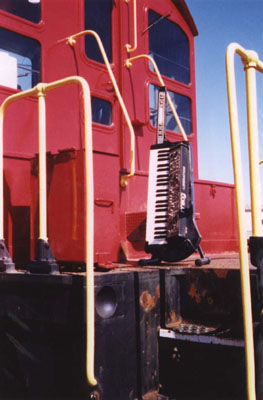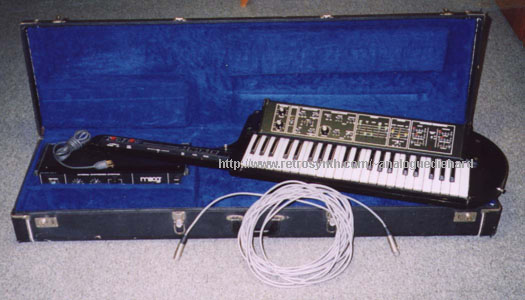Moog Liberation monophonic analog synthesizer
Last Update 01/29/2012
Try as I could, this one was not a favorite. It saw action on
stage for playing the Frankenstein solo in my club band (see above
pic). It never saw much use in my studio for many reasons:
- Thin sounding - not a minimoog at all
- Filter resonance not very flexible
- Inadequate facilities for bass synth voices
- Heavy when going "keytar" - 14 pounds (use a WIDE guitar strap
and straplocks)
- Useless "polyphonic" section
- No MIDI retrofit possible (at least then)
This was one of those acquitisions when Moogs were cheap during the
"great analog dump" of the 1980s when everybody was going to digital
keyboards. As is the case with most used vintage keyboards, this
one needed work as the pressure sensor had a bad CA3080 and a couple of
the rocker switches went bad (if yours has red switches on the neck,
it's my old unit. No I don't want it back). I also quickly
removed the dreaded "rotted foam" around the slidepots before that crap
got inside and ruined the slidepot assemblies.
The Liberation was introduced in 1980 and was available in black or
white. The pitch ribbon could be replaced with a pitch wheel on
special order. It was a "keytar" synthesizer that was designed to
be used in standard position or strung over your shoulder like a
guitar so you can strut to the front of the stage and hog the
spotlight. A 40 foot multiple conductor cable attached it to the
external power supply which also had synthesizer interfaces on the
front panel.
The best feature about the Liberation is the expression controls on the
neck.
It had monophonic aftertouch (AT) which was a mechanical shutter on a
pivot that activated an optical sensor. Moog labeled it
"force". It was a decent controller and could be routed to some
interesting stuff. You could use AT to open the filter, double as
a mod wheel or pitch wheel, and when the hard sync was on AT worked
only on the sync'd VCO, which was great for sweeping NASTY sounding
hard sync sounds (very effective for emulating guitar
"feedback"). The amount of AT was variable. It was a little
stiff but not too bad.
There are miniature "wheels" for mod wheel, filter sweep, and
volume. Also included is switch for glide and a pitch bend ribbon
which is essential for a keytar. Moog wisely labeled the neck
controls on the side where they could be easily seen from the
performer's perspective.
Moving to the main control panel, you get the standard monophonic
VCO->VCF->VCA architecture with LFO and glide. All the
controls are slidepots with the exception of tuning and VCO detune (any
tuning control is MUCH easier with a rotary pot). The LFO
generates square/triangle/S&H waveforms and can auto-trigger the
EGs (nice feature). An LED gives a visual indication of the LFO
rate. The LFO was routable to the VCOs and/or the filter and
either routing could be controlled by the wheel or the AT. The
LFO does not go into audio range so you can't get clangorous FX with
the filter or VCOs..
You get two hard-syncable VCOs with
triangle/ramp/pulse waveforms with some limitations - the octave
switches don't go low enough for bass synth voicing, there is no
variable pulse width, and VCO#1 pulse wave is fixed at 35% pulse &
VCO2 at square wave. Octave range only went from 32' to 8' for
VCO1, and 16' to 4' for VCOs - limited in my book. Waveform
selection and octave is independent per VCO, not shared
like the Rogue. A five input mixer varies the level of the
two VCOs, noise source, ring mod, and "poly". "Poly" is a cheesy
divide-down organ system that puts out square wave only, you only have
one VCF for the entire system, it is a key-on/key-off therefore there
is no release tail, and expression
controls do not affect it - pretty useless. The ring mod uses
each VCO for carrier and modulator and is the meatiest sound source in
the Liberation. The noise source wasn't very useful because the
filter wasn't very good.
The filter is standard 24dB/oct ladder filter although the EMPHASIS
control doesn't add much color to the resonance. It will
self-oscillate at maximum resonance. Keyboard tracking was off,
half, or full - that was the convention for a monophonic back in
1980. Sadly there is no facility for VCO FM which would had added
some variety to its very limited palette of sounds. I've played
almost every monophonic Moog from this era and the Liberation easily
has the wimpiest ladder filter.
The VCA and filter has their own dedicated EGs with ADS controls, with
switchable release shared with the decay control. A nice feature
is a LED that indicates the EGs are being triggered.
How does it sound? Despite its excellent expression controls,
this was the wimpiest monophonic in my arsenal. The filter takes
most of the blame here - its resonance has very little color, and it
doesn't get "fat" like my other monophonics like my Minimoog and Source. It can do a basic lead synth
sound but not much else. Doesn't do bass, doesn't do FX, and
forget about polyphonic. This was designed years before MIDI and
it was a shame that there wasn't a MIDI retrofit available because it
would had made an excellent MIDI controller with its expression
controls. And that cable wasn't always noise-free as the system
used the connector shell for ground and this didn't always make a
reliable contact. And despite similarities in appearance, the
Rogue and Prodigy sound much better because their circuits were
different.
The external power supply houses the interfacing - CV output and S-trig
outputs. The CV output is well thought out as it incorporated
keyboard CV, pitch bend, and LFO CV (including AT) all in one CV.
SCALE and
RANGE controls are provided for interfacing to non-Moog
synthesizers. A rocker switch controlled whether these outputs
were active.
When I bought my unit it was missing the case. Moog Music was
still around back then and they had one left in stock but it was
damaged. I acquired the last Liberation case from the
factory. The damage was superficial and the case was still
useable, but they weren't durable.
Not many artists used the Liberation. Moog Cookbook used
them. Jan Hammer, the ultimate
keytar artist, never used one. Devo was featured in ads but they
didn't use them for long. Tom Coster formerly of Santana routed
one through a guitar rig to emulate a guitar. Tom Schuman of
Spiro Gyra was shown in ads, but his onstage unit was a prototype
controller only with no onboard synthesizer system. In fact I
can't think of a song that became popular that featured the
Liberation. When our club band covered Edgar Winter's
"Frankenstein", I used the Liberation to cover the solo. Band
members used to introduce the song by proclaiming that they brought
"the monster".
When I got my Voyager it had much better expressive devices and could
be synced to MIDI, so I sold the Liberation in 2005. Today there
are MIDI retrofits available that could be used to MIDIfy the
Liberation but I already gave it up for other reasons.
And what is the heck is that red thing in the pic with the
Liberation? It's the back of a train locomotive - choo-choos are
another hobby of mine. For the trainspotters it's an EMD SW-1
from the Owego & Harford short line railroad.

Home





